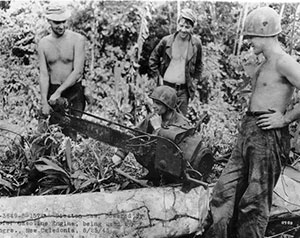Mercury and the military

Mercury's affiliation with the U.S. military – like many of its earliest projects – was circumstantial.
Today, Mercury Marine products are used by military, law-enforcement and emergency-services agencies the world over. But in 1941, WWII aluminum restrictions brought production of outboards to a virtual stop. A year later, the U.S. government issued Limitation Order 80, prohibiting the manufacture of leisure products from aluminum, and federal agents entered factories unannounced to assure compliance. The act halted outboard production at the still-young Kiekhaefer Corporation (destined to become Mercury Marine).
But as he did so many times, Carl Kiekhaefer turned a sow's ear into a silk purse, becoming the largest manufacturer of two-man chain saws for military use. Additionally, in order to continue engine research and development for future outboards, yet remain in compliance with war-time restrictions, Kiekhaefer started work on a new project under the direction of the U.S. Army Air Corps. The Air Corps was looking to power radio-controlled target drones used in air-combat gunnery practice. By providing chain saws for military uses, Kiekhaefer Corporation had built a reputation for fast, flexible and innovative engineering.
The prototype Y-40 became a twin-cylinder, horizontally opposed, two-cycle engine that weighed 34 pounds and produced 35 horsepower – a great technical achievement because it produced at least one horsepower for every pound it weighed. The company's products performed in every theater of war and earned the highest marks for performance, reliability and ease of operation.
Mercury, 'God of Speed'

Utilizing resources from the development of private- label outboards for two major retail stores, Kiekhaefer Corporation introduced Mercury Outboards at the New York Motor Boat Show in January of 1940. The five models – three single-cylinder and two twins – were simply named K1 through K5.
Kiekhaefer engineers streamlined the gas tanks and lower units to create the "slimmest, most compact" outboard available. But enhancements were more than just cosmetic: Performance-improving developments included reed valves for reducing backfires, the Kiekhaefer-designed Twin-Flux Magneto and the Rotex Positive Water Pump, which doubled engine- cooling-water capacity. The motors ranged in price from $42.95 to $98.50. By September nearly 3,000 units were shipped.














